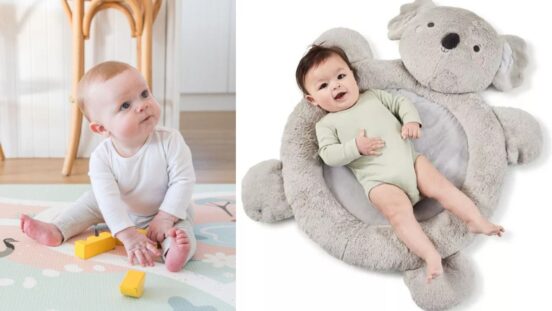6 week old: How to boost your baby’s brain development
Your baby's brain is growing at an incredible rate - here's one easy way you can give it a boost.
Brain power, babywearing and your body
Brain power
You might think that all your six-week-old does is eat, sleep and have her nappy changed but she's busy growing her brain at an incredible rate.
During every second of the early months, a thousand neural synapses – the pathways that are formed from memories of experience – will grow in her brain.
Your little one will continue to crave social interaction and engagement with you as well as observing the world around her. But she has no ability yet to screen out stimulus so watch out for signs she needs some down time.
Want to make your baby's brain grow even more? Then give her a cuddle! Research shows babies who are frequently cuddled have a thicker part of the brain called the "hippocampus", which leads to improved focus and memory.

A cuddle helps your bub's brain to grow.
Baby-wearing
Babywearing may help to settle and soothe your six-week-old, as being next to your body helps her feel safe. It will also leave your hands free too. An inward-facing carrier (holding her across your body or upright) allows her to look up at your face once her neck muscles are strong enough. The upright position offers the same benefits as tummy time and reduces the time he spends lying on his back.
Then, when she's older, turning her outwards will increase her interest in her surroundings.
All the movements you make while your babywearing help stimulate her vestibular system, important for balance and gross motor skill development.
When choosing a carrier, it's important to look for one which:
• allows healthy hip positioning for your baby
• is safe to use
• is comfortable for you to wear.
Healthy hip positioning is important to encourage normal hip development in babies and reduce the risk of developmental dysplasia of the hip.
Your baby carrier should allow your baby's hips to spread so his legs are straddling your body. Your baby's knees should be spread apart, his thighs should be supported, and his hips should be bent.
Your body after birth
The first six weeks after childbirth are tough on your body. Your core muscles are weakened in pregnancy, so lifting and cradling can cause aches and pains. Consult your GP to check your post-birth body is ready before starting any exercise regime.
Then, to ease the pain and regain muscle control, try these simple exercises at home:
• Every time you lift your baby engage your pelvic floor muscles, then draw them up to your belly button to keep them strong and toned.
• Don't hunch over when you're breastfeeding; keep your back straight and use pillows to support your baby during a feed, so you're not bearing her weight for prolonged periods.
• Go out for walks, making sure your pram handles are high enough to allow you to stand up straight.
• To help shape up your tummy, sit on an exercise ball or on a stool and, with your feet flat on the ground, gently lean backwards, hold the position, then return to sitting upright.




